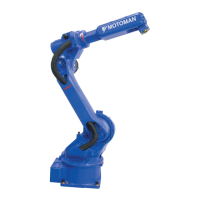3 Developing with MLX200
3.3 Programming Introduction
3-13
168542-1CD
168542-1CD
MLX200 Software and
Operations
• 1, S-Curve Profile - in this profile, the acceleration profile has a
sine-wave shape with the maximum acceleration being reached at
its peak. This will provide a smoother ramp-up and ramp-down
portions of the motion.
• 2, Jerk-Limited Profile - in this profile, a trapezoidal shape is defined
at the acceleration level using the Maximum Jerk values. This
provides similar smoothness to the S-Curve profile, but allows the
user more freedom in shaping the profile by adjusting the jerk
parameters as well as the acceleration and deceleration.
3.3.4.3 Blend Factor
The Blend Factor parameter is used to define at what point a motion
should begin to blend into the next queued motion. The valid values for
this are 0-8 with 0 defining a motion that stops at the trajectory segment
end point and 1-8 using distances defined inside the MLX200 Robot
Configuration files. Fig. 3-13 "Example of Blend Factor Effect on Motion"
on page 3-14 shows a graphical representation of how increasing Blend
Factor affects the shape of the trajectory.
Robots that have the Dynamic Trajectory Optimization
feature will ignore the Trajectory Shape parameter and use
an internally optimized trajectory shape.
Blend Factor only applies to Robot Motions and the blend
distances are defined as the Cartesian Distance from TCP
to trajectory end point.

